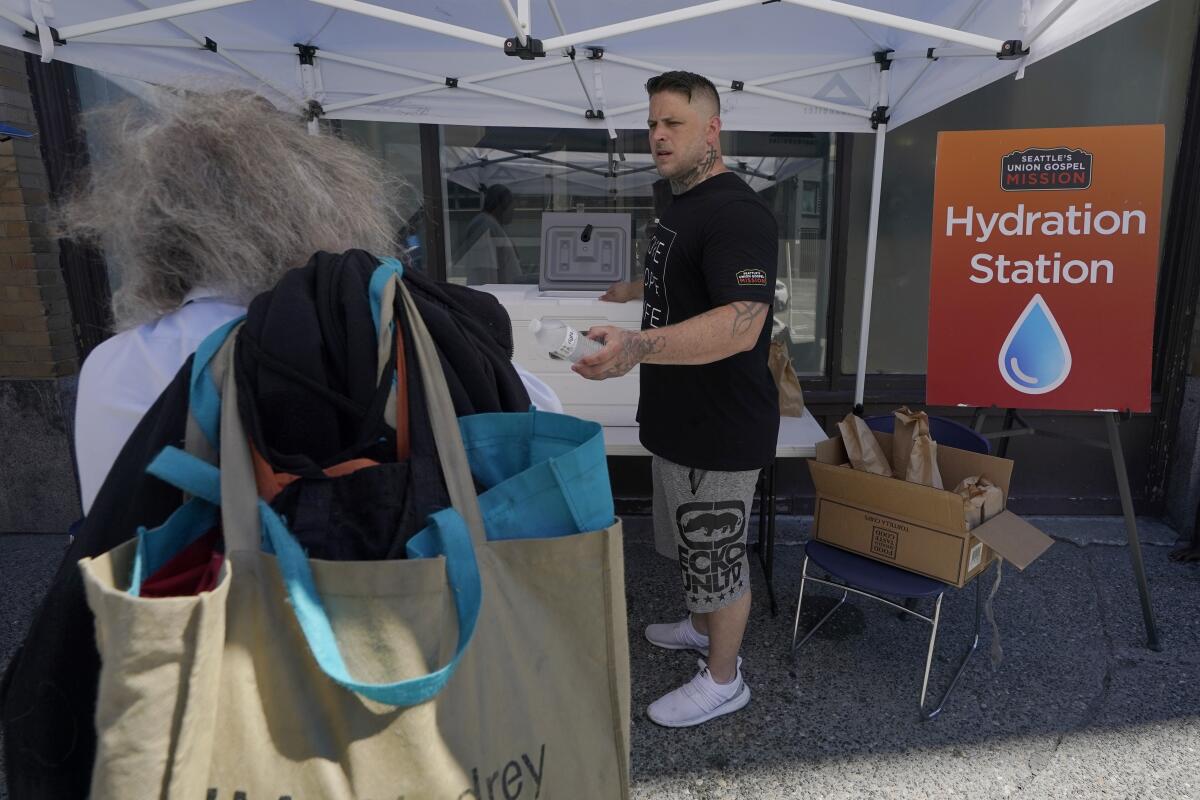Editorial: Record-setting heat wave shows that climate change is creating hell on Earth

- Share via
The record-breaking heat wave baking the West Coast is another painful sign that climate change is here, and we have to adapt.
The Pacific Northwest has been sizzling, with conditions forecasters have described as unprecedented and life-threatening. Portland, Ore., hit 113 degrees Monday, breaking the previous all-time high of 112 degrees, set Sunday. About 100 miles to the south, in Eugene, the U.S. track and field Olympic trials were halted Sunday afternoon, and spectators were asked to evacuate the stadium, due to the extreme heat.
Seattle hit 107 degrees, also a record high. It was so hot in recent days that the city closed at least one public pool amid concerns that visitors would burn their feet on the deck. And further north, the town of Lytton in British Columbia hit 116 degrees Sunday, the highest temperature ever recorded in Canada.
All of this is happening in June — the very beginning of summer. If it wasn’t already clear that climate change is fueling more extreme weather patterns, this unprecedented heat wave is another blistering example. There is surely more to come, as the heat dome responsible for the record-breaking temperatures is expected to linger in the Northwest, moving slowly toward Idaho and Montana.
Yet in a sense, the furnace-like conditions are just a replay of last year, which tied 2016 for the hottest year on record. Not coincidentally, 2020 was also the worst year on record for wildfires, with more than 10 million acres burned. And this trend is bound to continue as temperatures are driven upward by the warming effects of human activities that spew carbon and other heat-trapping compounds into the atmosphere.
The current heat wave is another visceral reminder that the world is not moving fast enough to curtail the use of fossil fuels and reduce carbon emissions. To prevent the worst effects of climate change will take dramatic change on the part of the world’s industrialized nations, most especially the United States.
But, alas, it’s not enough to focus on weaning ourselves from carbon fuels. As this heat wave demonstrates, we are already feeling the effects of climate change, and we are woefully unprepared.
Just think about how higher-than-normal temperatures in the Pacific Northwest have crippled basic infrastructure. In Washington, the state patrol closed a portion of a highway after the asphalt started to crack and buckle under the heat. In some areas — unaccustomed to such weather — school buses had no air conditioning and couldn’t safely transport students to summer school.
In Portland, the city’s light rail and streetcars were taken out of service. The transit system was designed for mild weather, with temperatures typically between 40 and 70 degrees. While the transit agency has made adjustments to the system in recent years to withstand more intense heat, it cannot safely operate when the mercury goes above 110 degrees, as it did on Sunday and Monday.
Many of the country’s roads, transit systems, dams, levees and energy grids were built decades ago, designed for different temperatures and less-extreme weather fluctuations. A record-breaking heat wave in California last summer triggered rolling blackouts; heat-driven outages will be a risk this year, too. A record-breaking cold snap in Texas earlier this year also led to mass power outages. The nation’s infrastructure is not prepared to withstand the onslaught of climate change, which can push temperatures to extremes in both directions.
U.S. lawmakers are beginning to act on the seriousness of the threat. The $1.2-trillion bipartisan infrastructure bill includes funding to modernize energy, transportation and water systems. The bill also includes $47 billion specifically for projects aimed at making our infrastructure more resilient to climate change. But the compromise package has, so far, shortchanged investments in clean energy, clean transportation and large-scale climate-proofing.
The need is great, and the funding is still too little. The reality is that climate change will cost the United States, no matter how quickly it responds. We can pay now to avoid greater damage or pay later, when the nation is forced to manage more deadly heat waves, wildfires, floods and other disasters.
More to Read
A cure for the common opinion
Get thought-provoking perspectives with our weekly newsletter.
You may occasionally receive promotional content from the Los Angeles Times.










